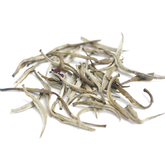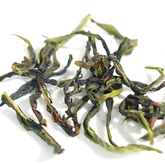Osmanthus Tea: A Fragrant Chinese Floral Tea and Complete Guide |NPTEA
In Chinese tea houses, jasmine tea is a common welcoming tea and a relatively well-known floral tea. It is often the tea that is served at Chinese restaurants . However, another floral tea with a long history and unique Eastern charm—Osmanthus Tea—is often overlooked.
In fact, Osmanthus tea has a tradition of being consumed in China for over a thousand years. It is a fusion of tea leaves and the delicate aroma of fresh osmanthus flowers . It not only has a sweet and elegant taste but is also imbued with beautiful symbolism, regarded in China as a "Tea of Auspiciousness."
This article will provide a comprehensive guide to Osmanthus tea's origins and production areas, its historical background, flavor profiles, production process, brewing methods, storage techniques, and health benefits. It will also offer purchasing advice for international tea lovers, helping everyone better understand and appreciate this unique representation of Chinese tea culture.
Recommended purchase:
Where Is Osmanthus Flower ?
Osmanthus fragrans, commonly known in English as Sweet Olive or simply Osmanthus, is a highly fragrant plant. Its Latin name, fragrans, literally means "aromatic," highlighting the plant's most notable characteristic. The tree typically grows to 3–12 meters tall, with leathery, evergreen leaves.

While the individual osmanthus flowers are quite small, their collective scent is incredibly strong, earning them the reputation of being "fragrant for ten miles." The aroma is rich yet elegant, with a profile that combines notes of apricot, peach, and honey, creating a sweet and refreshing fragrance. This unparalleled scent is why osmanthus is widely used in Chinese food, perfumes, and traditional Chinese medicine.
Beyond its beautiful appearance, osmanthus plays a significant role in Chinese culture:
Culinary Uses: It's used to make traditional treats like osmanthus cakes, osmanthus sugar, and osmanthus wine, adding a distinct floral aroma to dishes.
Beverages: Osmanthus tea is one of the most popular Chinese floral teas, blending the flower's sweet fragrance with a delicate tea base.
Health Benefits: In traditional Chinese medicine, osmanthus is believed to warm the stomach, resolve phlegm, and relieve coughs.

In short, osmanthus is more than just a plant; it's a cultural symbol that represents the beauty of autumn, good fortune, and a unique aromatic experience in Chinese tea culture.
Where Does Osmanthus Tea Come From?
The unique charm of osmanthus tea comes from the dual combination of "flower" and "tea." Its main ingredients are osmanthus flowers and loose-leaf tea. Therefore, when discussing the origin of Osmanthus tea, it is necessary to introduce both the main osmanthus-growing regions and the core tea-producing areas.
Osmanthus Flower Regions
Osmanthus is a traditional aromatic plant native to China, with a cultivation history spanning over 2,500 years in Asia. Its most representative production areas are in southern China, including Guilin in Guangxi province (the most famous), Taoyuan and Changsha in Hunan, Suzhou in Jiangsu, and Xianning in Hubei.

Tea Leaves Sourcing Regions
The base for Osmanthus tea is typically green, oolong, or black tea, sourced from a wide range of regions:
Green Tea types: Commonly from Zhejiang (such as Longjing ), Anhui (such as Huangshan Maofeng), and Jiangsu (such as Biluochun).
Oolong Tea types: Primarily from Fujian (such as Tie Guan Yin and Wuyi Rock Tea) and Guangdong (such as Phoenix Dan Cong ).
Common Types of Osmanthus Tea
The appeal of osmanthus tea lies in its rich variety. It refers not to a single type of tea, but to a series of floral teas "scented" with osmanthus. By pairing with different tea bases, unique and flavorful osmanthus tea blends can be created.
Osmanthus Oolong Tea: This is one of the most common types of osmanthus tea. Using a light-fragrance oolong tea as the base, it offers a refreshing and mellow taste. It perfectly combines the depth of oolong teawith the subtle elegance of osmanthus, making it a top choice for those who appreciate layered flavors.
Osmanthus Black Tea: This tea uses a fully fermented black tea as its base and is also widely available on the market. Black tea is mild and full-bodied, and when combined with the sweet fragrance of osmanthus, the tea liquor becomes a beautiful reddish-brown. The flavor is richer and smoother.

Osmanthus Green Tea: While less common than the other two, it can also be found. It uses an unfermented green tea as the base, which maximizes the tea’s fresh and vibrant character.
The Production Process of Osmanthus Tea
What makes osmanthus tea unique is its purely natural, additive-free production process, which sets it apart from many Western teas with artificial flavors. The core technique is the ancient art of "scenting" (窨制, yìn zhì), where tea leaves naturally absorb the aroma of the flowers. This process requires extensive manual labor, making it costly and resulting in low output.
Ingredient Preparation: Fresh osmanthus flowers are hand-picked. Because their blooming period is very short, and they must be picked in the early morning when the aroma is at its peak, the raw materials are extremely precious. This scarcity directly contributes to the limited production and higher cost of Osmanthus tea. Tea leaves are also hand-picked and processed into finished loose tea.
Scenting (Yìn zhì): The tea master layers the fresh osmanthus flowers and tea leaves in precise proportions, creating alternating layers of flower and tea. This is like giving the tea a natural "aroma bath," allowing the leaves to slowly absorb the sweet fragrance of the osmanthus.
Ventilation and Heat Dissipation: Since fresh osmanthus flowers contain moisture, the tea master must regularly open up the pile and gently turn the mixture every 2-3 hours. This prevents the tea from getting damp and ensures an even absorption of the aroma. This step requires significant effort and skill.
Re-drying: After the tea leaves have fully absorbed the fragrance, the master sifts out the flower residue and then low-temperature bakes the tea. This not only removes the moisture absorbed during the scenting process but also locks the fragrance firmly into the tea leaves, ensuring a long-lasting aroma.
The Taste of Osmanthus Tea
The unique flavor of Osmanthus tea lies in its clever fusion of the tea's natural taste with the subtle fragrance of osmanthus. The different tea bases provide a completely different flavor experience. Here are the flavor characteristics of the most common types:
Osmanthus Green Tea
It has a refreshing and crisp taste with a light yellow or slightly green liquor. The fresh notes of the green tea are like cucumber or green apple, while the sweetness of the osmanthus is like a hint of honey. The overall experience is light and thirst-quenching, perfect for summer or for those new to floral teas.
Osmanthus Black Tea
This tea is rich and smooth, with a bright red liquor. The black tea base tastes like dark chocolate or caramel, and the added osmanthus fragrance is like scattering flower petals over a dessert. Osmanthus black tea is both warming and sweet, making it ideal for the fall and winter seasons.
Osmanthus Oolong Tea
This type has the most complex flavor profile. Oolong tea naturally has a hint of orchid-like fragrance, and when combined with the scent of osmanthus, the aroma is a delightful blend of orchid and honey.
The tea liquor is smooth and well-rounded, with a light flavor up front and a pleasant aftertaste. It has both the freshness of green tea and the body of a darker tea, making it the most representative flavor of all Osmanthus tea varieties.
How to Brew Osmanthus Tea Correctly
The fragrance of Osmanthus tea is delicate. If the water temperature or brewing time is not right, it can easily disrupt the balance of the flower and tea flavors. Below are recommended brewing methods for Osmanthus Black Tea and Osmanthus Oolong Tea. A general rule is to use slightly lower temperatures, as this will best preserve the osmanthus aroma.
Brewing Osmanthus Black Tea
Teaware: A porcelain cup, glass pot, or Western-style teapot will work well.
Tea Leaves: About 4–5 grams (about one teaspoon) per 250 ml of hot water.
Water Temperature: 90°C (boiled water cooled for a bit).
Steeping Time: Steep for 2–3 minutes for the first brew, then gradually extend to 4–5 minutes for subsequent brews.
Brewing Osmanthus Oolong Tea
Teaware: A gaiwan or small teapot is highly recommended (Gongfu cha style brewing will best reveal the complex layers).
Tea Leaves: About 5–7 grams per 150–200 ml of hot water.
Water Temperature: 85–90°C. Avoid direct boiling water to prevent damaging the osmanthus fragrance.
Steeping Time: The first steep should be for just 10 seconds, then quickly pour out the liquor. Subsequent steeps can be gradually extended.
How to Choose High-Quality Osmanthus Tea
Choosing a high-quality Osmanthus tea requires some expertise, as the market contains artificially flavored teas and poorly made blends. To ensure you purchase an authentic tea, here is some crucial buying advice.
Beware of Artificially Flavored Tea
The aroma of genuine Chinese Osmanthus tea is natural, subtle, and long-lasting, a result of the scenting process. It should not smell artificial or pungent. Teas with artificial flavorings often have an overpowering scent that fades quickly and smells noticeably different from real osmanthus. To avoid these, choose reputable brands and carefully check the ingredient list.
Check for Freshness and Shelf Life
Like other floral teas such as jasmine tea, the aroma of Osmanthus tea will gradually dissipate over time. Unlike Pu-erh tea, it does not improve with age. The best flavor is found within one year of production. If stored improperly, the aroma will fade even faster. Therefore, always check the production date when buying and aim for freshly made tea.
Price and Quality
High-quality Osmanthus tea requires a significant amount of fresh osmanthus flowers and a premium tea base, along with a complex, labor-intensive scenting process. This makes the cost higher. If the price is very low, it is likely made with low-quality tea or artificial flavoring. Some poor-quality products simply mix flowers and tea leaves without the scenting process, which drastically reduces the cost but results in a weak aroma.
Consider Buying Samples
Given the inconsistent quality on the market, the safest and most reliable method is to first buy small samples to taste. By brewing and tasting it yourself, you can judge if the aroma and flavor are natural and long-lasting, helping you find the right Osmanthus tea for you.
How to Store Osmanthus Tea Correctly
The "soul" of Osmanthus tea is its natural aroma, which is very delicate and easily lost. To preserve its fresh flavor to the maximum extent, proper storage is essential. Here are a few key principles that will help you effectively store your Osmanthus tea.(Further Reading: How to Properly Store Your Tea? )

Airtight Container: The storage container for your Osmanthus tea must be airtight. When exposed to air, the fragrance absorbed by the tea will quickly dissipate. Use an opaque, sealed tin or a foil bag with a zip-lock closure.
Protect from Light: Exposure to light will accelerate the oxidation of the tea, degrading its aroma and flavor. Store your Osmanthus tea in a cool, dark place, away from direct sunlight.
Keep it Dry: A humid environment is the greatest enemy of tea, as it can cause mold. Ensure the storage area is dry and away from humid spaces like kitchens.
Drink it Soon: Osmanthus tea does not age like Pu-erh tea. Its best flavor is typically within one year. Therefore, to enjoy it at its finest, it is recommended to drink it as soon as possible after purchase.
Is Osmanthus Tea Good For You?
Osmanthus tea is a truly healthy beverage with benefits supported by both traditional Chinese medicine and modern scientific research.
-
Antioxidant Properties
Chinese studies published in journals like the Journal of Medicinal Food show that osmanthus is rich in phenolic compounds and flavonoids, which have significant free-radical scavenging abilities. This can help combat oxidative stress and slow down cellular aging. An experiment published in Scientific Reports (part of the Nature Publishing Group) also noted that when osmanthus tea is paired with green tea, the antioxidant effect can even be synergistically enhanced.
-
Supports Respiratory Health
A study on animals in the Journal of Ethnopharmacology showed that osmanthus extracts can significantly reduce inflammatory cells in the respiratory tract and lower IgE levels, a marker for allergic reactions. This provides modern scientific evidence for the traditional Chinese medicine belief that "osmanthus can resolve phlegm and stop coughing."
-
Aids Digestion and Relieves Stomach Discomfort
According to a review in Frontiers in Pharmacology and traditional Chinese medicine literature, osmanthus is widely used to relieve indigestion, bloating, and menstrual cramps. Modern herbal medicine resources (like Rucha Remedies health guides) also state that osmanthus tea can help promote bowel movements and ease digestive discomfort.
-
Appetite Regulation and Weight Management
Research from Nara Women's University in Japan and Scientific Reports found that the aroma of osmanthus can affect neurotransmitter levels in the brain related to appetite, which can help reduce the desire to eat. This suggests that Osmanthus tea not only provides a fragrant experience but may also play a role in portion control and weight management.
-
Stress Relief and Mood Enhancement
Tea and aroma research at Hong Kong Polytechnic University indicates that the fragrance of osmanthus has a calming effect similar to aromatherapy, effectively easing tension and anxiety. Drinking Osmanthus tea allows its floral scent to create a sense of well-being, making it an excellent choice for relieving daily stress.
-
Skin and Eye Health
The TeaLife tea research team in Australia points out that osmanthus contains carotenoids, which can be converted into Vitamin A in the body. This is beneficial for vision protection and skin health. Paired with its antioxidant properties, regular consumption of Osmanthus tea can help maintain skin radiance.
-
Anti-Inflammatory and Potential Anti-Tumor Activity
A 2023 study published in Plants (from MDPI) reported that osmanthus extract, under laboratory conditions, showed an ability to inhibit the release of inflammatory factors and suppress the proliferation of certain tumor cells. While more clinical trials are needed, this suggests that the active compounds in Osmanthus tea may have potential in preventing inflammation and diseases.
Summary of Osmanthus Tea
Osmanthus tea is a classic representative of traditional Chinese floral tea, with Osmanthus Black Tea and Osmanthus Oolong Tea being the most common types. Unlike artificially flavored teas, authentic Chinese osmanthus tea is made by allowing tea leaves to absorb the natural aroma of osmanthus flowers, making its fragrance more natural and its nature healthier. Due to the labor-intensive scenting process and limited production, high-quality osmanthus tea is often more expensive.

The best shelf life for Osmanthus tea is between 6 and 12 months. It should be stored in an airtight, moisture-proof, and light-proof container and consumed as soon as possible after opening. Research shows that beyond its pleasant taste, it also provides health benefits such as antioxidant properties, improved digestion, and stress relief.
In short, Osmanthus tea is a unique beverage that combines both floral and tea aromas, making it a truly healthy, all-natural drink.
FAQs about Osmanthus Tea
Q1: What is Osmanthus Tea?
Osmanthus tea is a traditional Chinese flower tea made by scenting or blending tea leaves with fresh osmanthus flowers.
Q2: What does Osmanthus Tea taste like?
It has a sweet floral aroma with a smooth, refreshing taste, often described as having honey or apricot notes.
Q3: What types of Osmanthus Tea are there?
The most common types are osmanthus green tea, osmanthus oolong tea, and osmanthus black tea.
Q4: Is Osmanthus Tea natural?
Yes. High-quality osmanthus tea is made with real flowers through traditional scenting, not artificial flavoring.
Q5: How do you brew Osmanthus Tea?
Use hot water at 85–90°C (185–194°F), steep for 1–3 minutes, and enjoy multiple infusions depending on the tea base.
Q6: What are the health benefits of Osmanthus Tea?
Studies show it is rich in antioxidants, helps digestion, relieves stress, and supports overall wellness.
Q7: Does Osmanthus Tea contain caffeine?
Since osmanthus tea is made with tea leaves, it does contain caffeine, but usually less than coffee.
SEE MORE ABOUT TEA
If you are a beginner about Chinese tea:
Basic-Guide-to-Chinese-Tea
If you have questions about selecting tea:
Learn-more-about-chinese-tea
If you have questions about the benefits of tea:
Health-benefits-of-chinese-tea
If you have questions about brewing tea:
How-to-brew-loose-leaf-tea







